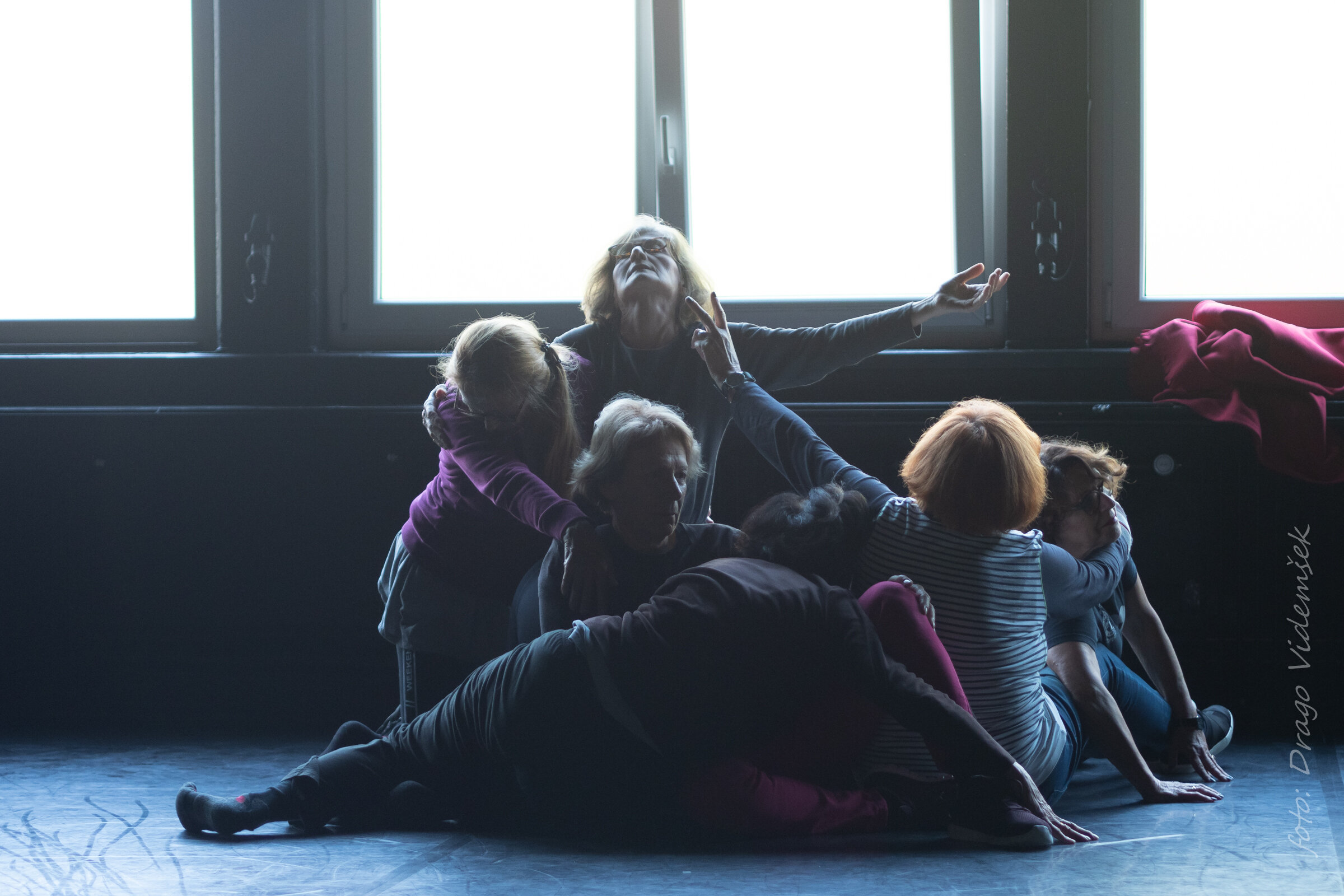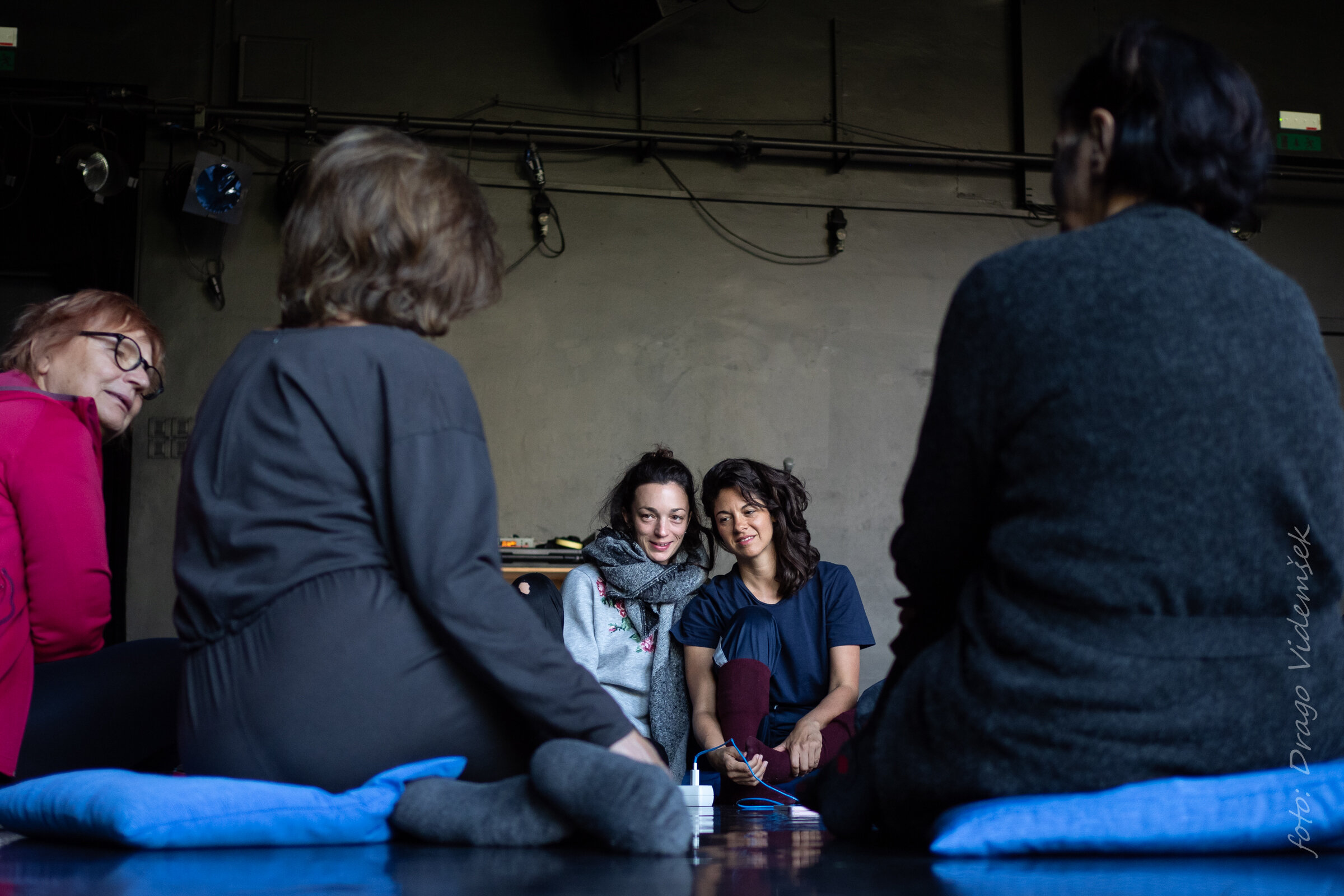LUGAR COMÚN / STIČIŠČA SREČANJ
sodobno performativno umetniški projekt / a contemporary performative art project
so skupaj zasnovali plesalka in koreografinja Carlota Mantecón, pevka Tamara Ascanio in glasbenica Luz Prado. Vse tri so članice kolektiva DERMIS TRAMA FICCIÓN.
was created by dancer and choreographer Carlota Mantecón, singer Tamara Ascanio and musician Luz Prado. All three are members of the colective DERMIS TRAMA FICCIÓN.
Dame in gospodje, starejši od 60 let, so bili v oktobru 2019 povabljeni na delavnico s koreografinjo Carloto Mantecón. Odzvalo se je devet ljudi, od tega osem žensk in en moški. Skupaj so raziskovali svojo lastno telesno avtonomijo, iskali in spoznavali so naravno gibanje svojega telesa. V drugem delu intenzivnih vaj se jim je pridružila tudi glasbenica Luz Prado, s katero so raziskovali zvočno pokrajino, ki jo ustvarjajo ob svojem plesu. Iz zbrane skupine ljudi smo izbrali tri posameznice, ki bodo sodelovale pri ustvarjanju predstave.
V procesu delavnice sta se izoblikovali dve pomembni temi za razvoj predstave, in sicer:
odnos do užitka, duševnega in telesnega ugodja;
odnos do poraza, nezmožnosti, zdrsa.
Občutek telesnega in duševnega ugodja so udeleženke iskale v avtonomiji giba, igrivosti telesa in odločnosti svojega plesa. Vir užitka so odkrivale v sprejemanju odločitev za samostojno, samozavestno in vsaki posameznici lastno gibanje. Užitek so našle tudi v odnosu med pripadnostjo skupini in lastno individualnostjo. Občutek, ki nastopa kot nasprotje užitku in ga tudi omejuje, pa je neuspeh. Telo se z leti spreminja, vedno manj je gibčno, in željo po gibu pogosto omeji bolečina. Skozi proces je vsak posameznik razvil svoj unikaten način plesa, avtonomni gib. To je gib, ki nastane spontano, intuitivno in brez racionalnih meja. Razvije se nekje vmes, v prostoru med užitkom in zdrsom, med zmožnostjo in nezmožnostjo.
V predstavi se bomo spraševali: Katere omejitve nosi žensko telo? Katere omejitve nosi staro telo? Kje v telesu najdem užitek, ugodje? Kaj pomeni avtonomen gib? Kakšen je ples, ki se osvobodi družbenih pričakovanj in telo samo vodi gib? Kje se nezavedna želja po gibu sreča z besedo? Kako te besede postanejo pesem? In katera je tista pesem, tista beseda, ki nastane ob avtonomnem gibu telesa?
Projekt, v okviru katerega bomo leta 2020 ustvarili predstavo, se je začel leta 2019 s postopkom izbire v obliki delavnic na obeh lokacijah. Na Tenerifu je Carlota izbrala dve gospe in enega gospoda.
In October 2019, ladies and gentlemen aged 60 or over were invited to participate in a workshop with choreographer Carlota Mantecón. Nine people responded, including eight women and one man. Together they explored their own physical autonomy, searching for and learning about the natural movement of their bodies. In the second part of the intense exercise, they were joined by musician Luz Prado to explore the soundscape they create while dancing. From the assembled group of people, three women were selected to participate in the creation of the show.
Two important topics for the development of the performance were formed in the course of the workshop:
attitude towards pleasure, both mental and physical;
attitude towards defeat, inability, failure.
The participants looked for a sense if physical and mental pleasure in the autonomy of movement, the playfulness of the body, and the determination of their dance. They found the source of pleasure in making decisions for an independent, confident, and individually specific movement. They also found pleasure in the relationship between belonging to a group and their own individuality. A feeling that acts as the opposite of pleasure, also limiting it, is failure. The body changes over years, it becomes less and less agile, and the desire to move is often limited by pain. Throughout the process, each participant developed their own unique dance style, their own autonomous movement. It is a movement that occurs spontaneously, intuitively, and without rational boundaries. It develops somewhere in between, in the space between pleasure and failure, between ability and inability.
In the performance, we will ask ourselves: What limitations does the female body carry? What limitations are there to the old body? Where in the body does one find enjoyment, pleasure? What does autonomous movement mean? What does a dance look like that is free from social expectations, where the body just guides the movement? Where does the unconscious desire for movement meet the word? How do these words become a song? And what is the song, the word that comes out of the autonomous movement of the body?
The project that will end with a performance in 2020 began in 2019 with a selection process in the form of workshops at bot location. In Tenerife, Carlota selected two ladies and a gentleman.
Foto / Photo: DRAGO VIDEMŠEK
O avtorjih
Carlota Mantecón (1984) se je rodila na otoku Tenerife v Španiji. Umetnica, ki dela na področju koreografije in uprizoritvenih umetnosti. Plesalka, koreografinja, performerka. Njeno delo je raziskovanje telesa v gibanju, od abstrakcije do dialoga z drugimi umetniškimi disciplinami. Med letoma 2016 in 2018 se je aktivno ukvarjala s starejšo generacijo prebivalcev na področju mest La Laguna in Santa Cruz na Tenerifu. Vodi redne vadbe ter delavnice na Balearskih otokih in na celini. Sodelavce iz Tenerifa si je izbrala glede na dosedanje izkušnje in potrebe pri projektu.
Izbor sodelavcev je narejen premišljeno, saj je dramaturginja Urša Adamič že ustvarjala predstave za to generacijo ljudi in s skupino mladih slovenskih ustvarjalcev v sezoni 2017/2018 ustvarila gledališko predstavo o demenci, s katero je želela pomagati tudi k destigmatizaciji bolezni. Navdih za gledališko raziskovanje teme izhaja iz osebne izkušnje režiserke Nine Šorak in dramaturginje Urše Adamič z njunima babicama. Na podlagi lastnih doživetij in zgodb svojih mam sta sestavili gledališko zgodbo, ki v ospredje postavlja odnos med mamo z alzheimerjevo boleznijo in sinom, ki vse bolj postaja njen skrbnik. V predstavi z naslovom Kje sem ostala sledimo odnosu, prilagajanju na nove okoliščine in obenem ohranjanju ljubeče povezanosti. Predstava temelji na dokumentarističnem pristopu k obravnavi teme vedenjske motnje, ki je posledica alzheimerjeve bolezni. S projektom pa ne želijo ostati le v polju gledališkega, temveč želijo nagovoriti svojce dementnih ljudi in tudi njih same. Zato so se povezali tudi s psihiatrom Vidom Voduškom ter društvoma Spominčica in Trepetlika, ki nudita pomoč bolnikom z demenco in Parkinsonovo boleznijo. Pred tem je dramaturginja tudi že sodelovala na mednarodnem gledališkem projektu v Španiji, tako da španski teater zanjo ni ravno novost.
About the authors
Carlota Mantecón (1984) was born on the island of Tenerife, Spain. An artist working in the field of choreography and performing arts. Dancer, choreographer, performer. She explores body in motion, from abstraction to dialogue with other artistic disciplines. Between 2018 and 2018, she was actively involved with the older generation of residents in the cities of La Laguna and Santa Cruz, Tenerife. She conducts regular classes and workshops in the Balearic Islands and on the mainland. She selected her Tenerife colleagues based on their experience and project needs.
The selection of collaborators was well thought out. Urša Adamič had already created performances for this generation of people, and created a theatre play about dementia with a group of young Slovenian creators in 2017/2018 to help destigmatize the disease. The inspiration for the theatrical exploration of the topic comes from the personal experience of director Nina Šorak and dramaturge Urša Adamič with their grandmothers. Based on their own experiences and stories told by their mothers, they created a theatrical story that highlights the relationship between a mother with Alzheimer's and a son who is increasingly becoming her caregiver. In Where Was I, we follow their relationship, their adaptation to new circumstances while maintaining a loving connection. The performance is based on a documentary approach to addressing the topic of behavioural disorder as a result of Alzheimer’s disease. However, they don’t want to remain solely in the field of theatre, but also to address the families of the demented, as well as the patients themselves. To this end, they teamed up with psychiatrist Vid Vodušek and the organizations Spominčica and Trepetlika, which provide assistance to patients with dementia and Parkinson’s disease. She has previously participated in an international theatre project in Spain, so the Spanish theatre is not exactly new to her.





